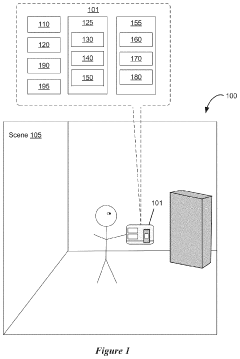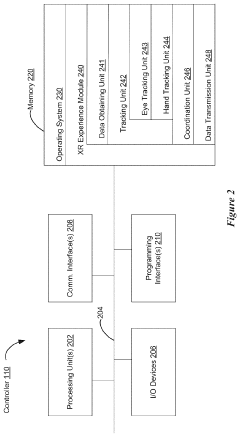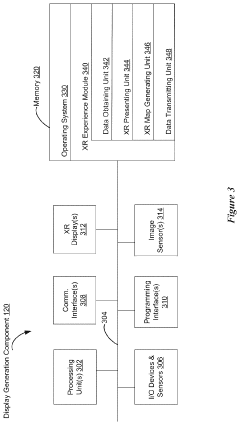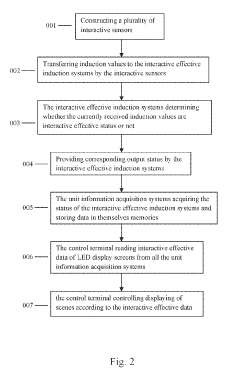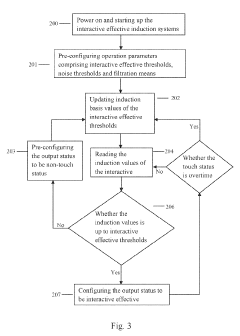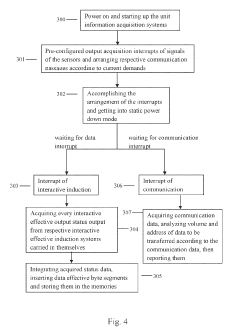ULED Displays Elevating Interactive Media
JUN 20, 20259 MIN READ
Generate Your Research Report Instantly with AI Agent
Patsnap Eureka helps you evaluate technical feasibility & market potential.
ULED Display Evolution
The evolution of ULED (Ultra Light Emitting Diode) displays represents a significant leap in display technology, building upon the foundation laid by LED and OLED technologies. This progression has been driven by the increasing demand for higher quality, more energy-efficient, and interactive display solutions across various sectors, including consumer electronics, automotive, and digital signage.
ULED technology emerged as a response to the limitations of existing display technologies. While OLED displays offered superior contrast and color reproduction, they faced challenges in terms of brightness and longevity. ULED displays aim to combine the best aspects of LED and OLED technologies, offering improved brightness, color accuracy, and energy efficiency.
The development of ULED displays has been marked by several key milestones. Initially, the focus was on enhancing the basic LED technology by reducing the size of individual diodes and improving their light output. This led to the creation of Mini-LED backlighting systems, which provided better local dimming capabilities and improved contrast ratios compared to traditional LED-LCD displays.
As the technology progressed, researchers and manufacturers turned their attention to developing true ULED displays, where each pixel is composed of ultra-small LEDs. This advancement required overcoming significant technical challenges, including the miniaturization of LED components, improving manufacturing processes to ensure consistent quality at scale, and developing sophisticated control systems to manage the vast number of individual light-emitting elements.
The latest iterations of ULED technology have focused on enhancing the interactive capabilities of displays. This has involved integrating touch sensitivity directly into the display panel, reducing latency, and improving the accuracy of touch detection. Additionally, efforts have been made to incorporate other sensing technologies, such as pressure sensitivity and even biometric sensors, directly into the display structure.
One of the most promising aspects of ULED evolution has been the development of flexible and transparent display panels. These advancements open up new possibilities for interactive media, allowing for the creation of curved, foldable, and even rollable displays that can seamlessly integrate into various environments and form factors.
The ongoing research in ULED technology is now centered on further improving energy efficiency, expanding color gamut, and increasing pixel density. There is also a strong focus on developing manufacturing techniques that can reduce production costs, making ULED displays more accessible for a wider range of applications and consumer products.
As ULED technology continues to mature, it is poised to revolutionize the way we interact with digital content, blurring the lines between the physical and digital worlds. The potential for creating immersive, responsive, and highly customizable display environments is driving ongoing innovation in this field, with significant implications for the future of interactive media and human-computer interaction.
ULED technology emerged as a response to the limitations of existing display technologies. While OLED displays offered superior contrast and color reproduction, they faced challenges in terms of brightness and longevity. ULED displays aim to combine the best aspects of LED and OLED technologies, offering improved brightness, color accuracy, and energy efficiency.
The development of ULED displays has been marked by several key milestones. Initially, the focus was on enhancing the basic LED technology by reducing the size of individual diodes and improving their light output. This led to the creation of Mini-LED backlighting systems, which provided better local dimming capabilities and improved contrast ratios compared to traditional LED-LCD displays.
As the technology progressed, researchers and manufacturers turned their attention to developing true ULED displays, where each pixel is composed of ultra-small LEDs. This advancement required overcoming significant technical challenges, including the miniaturization of LED components, improving manufacturing processes to ensure consistent quality at scale, and developing sophisticated control systems to manage the vast number of individual light-emitting elements.
The latest iterations of ULED technology have focused on enhancing the interactive capabilities of displays. This has involved integrating touch sensitivity directly into the display panel, reducing latency, and improving the accuracy of touch detection. Additionally, efforts have been made to incorporate other sensing technologies, such as pressure sensitivity and even biometric sensors, directly into the display structure.
One of the most promising aspects of ULED evolution has been the development of flexible and transparent display panels. These advancements open up new possibilities for interactive media, allowing for the creation of curved, foldable, and even rollable displays that can seamlessly integrate into various environments and form factors.
The ongoing research in ULED technology is now centered on further improving energy efficiency, expanding color gamut, and increasing pixel density. There is also a strong focus on developing manufacturing techniques that can reduce production costs, making ULED displays more accessible for a wider range of applications and consumer products.
As ULED technology continues to mature, it is poised to revolutionize the way we interact with digital content, blurring the lines between the physical and digital worlds. The potential for creating immersive, responsive, and highly customizable display environments is driving ongoing innovation in this field, with significant implications for the future of interactive media and human-computer interaction.
Interactive Media Market
The interactive media market has experienced significant growth and transformation in recent years, driven by technological advancements and changing consumer preferences. This market encompasses a wide range of digital content and platforms that allow users to actively engage with and manipulate media, including video games, virtual reality experiences, interactive videos, and social media platforms.
The global interactive media market size was valued at approximately $150 billion in 2020 and is projected to reach $250 billion by 2025, growing at a compound annual growth rate (CAGR) of 10.8%. This growth is primarily fueled by the increasing adoption of smartphones, tablets, and other connected devices, as well as the rising popularity of immersive technologies like augmented reality (AR) and virtual reality (VR).
Video games continue to dominate the interactive media landscape, accounting for over 60% of the market share. The gaming industry has seen a surge in mobile gaming, cloud gaming services, and esports, attracting a diverse audience across age groups and demographics. The COVID-19 pandemic has further accelerated the growth of the gaming sector, as people sought entertainment and social connections during lockdowns.
Social media platforms have also become a significant component of the interactive media market, with platforms like Facebook, Instagram, and TikTok continuously innovating to enhance user engagement through interactive features such as live streaming, augmented reality filters, and interactive advertisements. These platforms have become essential marketing channels for businesses, driving the growth of influencer marketing and social commerce.
The emergence of interactive streaming services and interactive storytelling has opened up new opportunities in the entertainment industry. Platforms like Netflix and YouTube have introduced interactive content that allows viewers to make choices that influence the narrative, blurring the lines between traditional media and gaming experiences.
In the education sector, interactive media has gained traction through e-learning platforms and educational apps that utilize gamification and interactive simulations to enhance learning outcomes. This trend has been further accelerated by the shift towards remote learning during the pandemic.
The advertising industry has also embraced interactive media, with brands increasingly using interactive ads, shoppable content, and AR experiences to engage consumers and drive conversions. This shift towards more immersive and engaging advertising formats is expected to continue as brands seek to cut through the noise in an increasingly crowded digital landscape.
As the interactive media market continues to evolve, emerging technologies such as 5G, artificial intelligence, and advanced display technologies like ULED are expected to play a crucial role in shaping its future. These technologies will enable more seamless, immersive, and personalized interactive experiences across various platforms and devices, further driving market growth and innovation.
The global interactive media market size was valued at approximately $150 billion in 2020 and is projected to reach $250 billion by 2025, growing at a compound annual growth rate (CAGR) of 10.8%. This growth is primarily fueled by the increasing adoption of smartphones, tablets, and other connected devices, as well as the rising popularity of immersive technologies like augmented reality (AR) and virtual reality (VR).
Video games continue to dominate the interactive media landscape, accounting for over 60% of the market share. The gaming industry has seen a surge in mobile gaming, cloud gaming services, and esports, attracting a diverse audience across age groups and demographics. The COVID-19 pandemic has further accelerated the growth of the gaming sector, as people sought entertainment and social connections during lockdowns.
Social media platforms have also become a significant component of the interactive media market, with platforms like Facebook, Instagram, and TikTok continuously innovating to enhance user engagement through interactive features such as live streaming, augmented reality filters, and interactive advertisements. These platforms have become essential marketing channels for businesses, driving the growth of influencer marketing and social commerce.
The emergence of interactive streaming services and interactive storytelling has opened up new opportunities in the entertainment industry. Platforms like Netflix and YouTube have introduced interactive content that allows viewers to make choices that influence the narrative, blurring the lines between traditional media and gaming experiences.
In the education sector, interactive media has gained traction through e-learning platforms and educational apps that utilize gamification and interactive simulations to enhance learning outcomes. This trend has been further accelerated by the shift towards remote learning during the pandemic.
The advertising industry has also embraced interactive media, with brands increasingly using interactive ads, shoppable content, and AR experiences to engage consumers and drive conversions. This shift towards more immersive and engaging advertising formats is expected to continue as brands seek to cut through the noise in an increasingly crowded digital landscape.
As the interactive media market continues to evolve, emerging technologies such as 5G, artificial intelligence, and advanced display technologies like ULED are expected to play a crucial role in shaping its future. These technologies will enable more seamless, immersive, and personalized interactive experiences across various platforms and devices, further driving market growth and innovation.
ULED Tech Challenges
ULED (Ultra Light Emitting Diode) displays represent a significant advancement in display technology, offering enhanced brightness, contrast, and energy efficiency compared to traditional LED displays. However, the development and widespread adoption of ULED technology face several technical challenges that need to be addressed.
One of the primary challenges is the manufacturing process of ULED panels. The production of ultra-small LED chips requires precise control over the epitaxial growth process and advanced packaging techniques. Achieving consistent quality and yield rates at scale remains a significant hurdle for manufacturers. Additionally, the miniaturization of LED chips introduces complexities in terms of heat dissipation and electrical connections, which can affect the overall performance and lifespan of ULED displays.
Another critical challenge lies in the driving and control mechanisms for ULED displays. The increased number of pixels and sub-pixels in ULED panels necessitates more sophisticated driving circuits and control algorithms. Developing efficient and cost-effective solutions for driving large arrays of ultra-small LEDs while maintaining uniform brightness and color accuracy across the entire display is a complex task that requires innovative approaches in both hardware and software design.
Color management and calibration present another set of challenges for ULED technology. Achieving wide color gamut and high color accuracy demands precise control over each individual LED's output. This requires advanced color management systems and calibration techniques that can account for variations in LED performance and aging over time. Furthermore, ensuring consistent color reproduction across different viewing angles and ambient lighting conditions adds another layer of complexity to the color management challenge.
The integration of ULED technology with interactive media applications introduces additional technical hurdles. Achieving low latency and high refresh rates is crucial for creating immersive and responsive interactive experiences. This requires optimizing the entire display pipeline, from content rendering to signal processing and pixel driving. Moreover, developing touch-sensitive ULED displays that maintain the technology's visual quality while providing accurate and responsive touch input is an area that demands further research and innovation.
Lastly, the challenge of power efficiency and thermal management cannot be overlooked. While ULED technology offers improved energy efficiency compared to traditional displays, the high brightness capabilities and dense pixel arrangements can still lead to significant power consumption and heat generation. Developing advanced power management systems and thermal dissipation solutions that can maintain optimal performance while minimizing energy usage and heat buildup is essential for the long-term viability and adoption of ULED displays in various applications, particularly in portable and wearable devices.
One of the primary challenges is the manufacturing process of ULED panels. The production of ultra-small LED chips requires precise control over the epitaxial growth process and advanced packaging techniques. Achieving consistent quality and yield rates at scale remains a significant hurdle for manufacturers. Additionally, the miniaturization of LED chips introduces complexities in terms of heat dissipation and electrical connections, which can affect the overall performance and lifespan of ULED displays.
Another critical challenge lies in the driving and control mechanisms for ULED displays. The increased number of pixels and sub-pixels in ULED panels necessitates more sophisticated driving circuits and control algorithms. Developing efficient and cost-effective solutions for driving large arrays of ultra-small LEDs while maintaining uniform brightness and color accuracy across the entire display is a complex task that requires innovative approaches in both hardware and software design.
Color management and calibration present another set of challenges for ULED technology. Achieving wide color gamut and high color accuracy demands precise control over each individual LED's output. This requires advanced color management systems and calibration techniques that can account for variations in LED performance and aging over time. Furthermore, ensuring consistent color reproduction across different viewing angles and ambient lighting conditions adds another layer of complexity to the color management challenge.
The integration of ULED technology with interactive media applications introduces additional technical hurdles. Achieving low latency and high refresh rates is crucial for creating immersive and responsive interactive experiences. This requires optimizing the entire display pipeline, from content rendering to signal processing and pixel driving. Moreover, developing touch-sensitive ULED displays that maintain the technology's visual quality while providing accurate and responsive touch input is an area that demands further research and innovation.
Lastly, the challenge of power efficiency and thermal management cannot be overlooked. While ULED technology offers improved energy efficiency compared to traditional displays, the high brightness capabilities and dense pixel arrangements can still lead to significant power consumption and heat generation. Developing advanced power management systems and thermal dissipation solutions that can maintain optimal performance while minimizing energy usage and heat buildup is essential for the long-term viability and adoption of ULED displays in various applications, particularly in portable and wearable devices.
Current ULED Solutions
01 ULED display technology for interactive media
ULED (Ultra Light Emitting Diode) displays are being utilized for interactive media applications. These displays offer high brightness, contrast, and energy efficiency, making them suitable for various interactive environments. The technology enables enhanced user engagement through touch-sensitive interfaces and responsive visual feedback.- ULED display technology for interactive media: Ultra-LED (ULED) display technology is utilized in interactive media applications, offering enhanced brightness, contrast, and color accuracy. This technology enables more immersive and responsive user experiences in various interactive media contexts, such as digital signage, gaming, and educational platforms.
- Interactive user interfaces for ULED displays: Advanced user interface designs are developed specifically for ULED displays, incorporating touch sensitivity, gesture recognition, and multi-modal interactions. These interfaces enhance user engagement and provide intuitive control mechanisms for interactive media content on ULED screens.
- Content optimization for ULED interactive displays: Techniques for optimizing content specifically for ULED interactive displays are implemented, focusing on high dynamic range (HDR) content, real-time rendering, and adaptive content scaling. These optimizations ensure that interactive media takes full advantage of ULED display capabilities, delivering superior visual quality and responsiveness.
- Integration of ULED displays with interactive media systems: Methods for seamlessly integrating ULED displays into comprehensive interactive media systems are developed. This includes synchronization protocols, low-latency data transmission, and adaptive content delivery mechanisms to ensure smooth operation of interactive media across ULED display networks.
- Energy-efficient interactive media solutions for ULED displays: Innovative approaches to reduce power consumption in ULED-based interactive media systems are implemented. These solutions include adaptive brightness control, selective pixel activation, and intelligent power management algorithms, ensuring energy efficiency without compromising the interactive experience or display quality.
02 Interactive content management systems for ULED displays
Content management systems are developed specifically for ULED displays in interactive media settings. These systems allow for real-time content updates, personalized user experiences, and seamless integration with various data sources. They enable dynamic content delivery and interactive features tailored to ULED display capabilities.Expand Specific Solutions03 Touch and gesture recognition for ULED interactive displays
Advanced touch and gesture recognition technologies are integrated with ULED displays to create highly responsive interactive media experiences. These systems can detect multiple touch points, complex gestures, and even proximity-based interactions, enhancing the user interface and expanding the possibilities for interactive applications.Expand Specific Solutions04 ULED display synchronization and multi-screen interaction
Technologies for synchronizing multiple ULED displays and enabling seamless multi-screen interactions are developed. These solutions allow for coordinated content display across multiple screens, interactive experiences that span multiple displays, and the ability to transfer content between screens intuitively.Expand Specific Solutions05 Data processing and rendering for ULED interactive media
Specialized data processing and rendering techniques are employed to optimize content for ULED displays in interactive media applications. These methods ensure high-quality visual output, smooth animations, and efficient handling of interactive elements, taking full advantage of the ULED display's capabilities while maintaining responsiveness.Expand Specific Solutions
ULED Industry Leaders
The ULED display market is in a growth phase, driven by increasing demand for high-quality interactive media experiences. The market size is expanding rapidly, with major players like LG Electronics, Samsung Display, and Apple investing heavily in research and development. The technology maturity varies, with established companies like Sony and Microsoft pushing boundaries in display quality and interactivity. Emerging players such as Wuhan China Star Optoelectronics and Shenzhen AOTO Electronics are also making significant strides. The competitive landscape is characterized by a mix of consumer electronics giants and specialized display manufacturers, each striving to innovate in areas such as picture quality, energy efficiency, and interactive features. As the technology evolves, we can expect further advancements in ULED displays, potentially revolutionizing interactive media consumption.
LG Electronics, Inc.
Technical Solution: LG Electronics has been advancing ULED display technology for interactive media applications. Their approach combines OLED technology with quantum dot enhancements to create ULED displays with exceptional color accuracy and contrast. LG's ULED displays feature ultra-thin designs and flexible form factors, allowing for innovative interactive installations. The company has also developed touch-sensitive ULED panels with multi-touch capabilities, enabling more intuitive user interactions. LG is exploring the integration of AI-powered content optimization to enhance the viewing experience on their ULED displays.
Strengths: Exceptional picture quality, flexible form factors for creative installations, and advanced touch capabilities. Weaknesses: Higher production costs compared to traditional LED displays, which may impact affordability for some applications.
Apple, Inc.
Technical Solution: Apple has been researching ULED technology for its potential application in future interactive devices. Their approach focuses on integrating ULED displays with their existing ecosystem of products. Apple's ULED development includes high pixel density displays with wide color gamut support, designed to work seamlessly with their touch-based interfaces. The company is also exploring ways to incorporate their TrueDepth camera system into ULED displays for advanced facial recognition and gesture control in interactive media applications.
Strengths: Seamless integration with existing Apple ecosystem, potential for advanced user interaction through facial recognition and gesture control. Weaknesses: Limited to Apple's closed ecosystem, which may restrict wider adoption in the broader interactive media market.
ULED Core Innovations
Devices, methods, and graphical user interfaces for interacting with media and three-dimensional environments
PatentPendingUS20240028177A1
Innovation
- The implementation of a computer system with a display generation component and input devices that detect user gaze and gestures to modify visual characteristics of media items, allowing for intuitive interaction through gaze-based feedback, reduced input requirements, and efficient zooming mechanisms, while distinguishing between stereoscopic and non-stereoscopic media items for enhanced user experience.
Interactive LED display device and display method thereof
PatentActiveUS20190139485A1
Innovation
- An interactive LED display device with a control terminal, unit information acquisition systems, LED modules, and interactive sensors, which communicate sensor information to achieve adaptive and stable interactive responses, using physical or capacitance sensors and microcontroller units to manage output status and maintain high-quality interactive effects.
ULED Energy Efficiency
ULED (Ultra Light Emitting Diode) displays have emerged as a promising technology in the field of interactive media, offering significant improvements in energy efficiency compared to traditional display technologies. The energy efficiency of ULED displays is a critical factor in their adoption and widespread use, particularly in applications where power consumption is a key consideration.
ULED displays utilize advanced semiconductor materials and innovative manufacturing processes to achieve superior energy efficiency. The core technology behind ULED displays involves the use of quantum dots or nanocrystals, which enable precise control over light emission and color reproduction. This results in displays that can produce vibrant, high-quality images while consuming less power than conventional LED or OLED displays.
One of the primary mechanisms contributing to the energy efficiency of ULED displays is their ability to achieve higher luminance levels with lower power input. This is accomplished through improved electron-hole recombination efficiency and reduced energy loss in the form of heat. As a result, ULED displays can maintain brightness levels comparable to or exceeding those of other display technologies while consuming significantly less power.
The energy efficiency of ULED displays also extends to their color reproduction capabilities. By leveraging quantum dot technology, ULEDs can produce a wider color gamut with greater precision, reducing the need for additional power-consuming color filters or backlight systems. This not only enhances the visual quality of the display but also contributes to overall energy savings.
Another factor contributing to the energy efficiency of ULED displays is their improved light management and optical design. Advanced light extraction techniques and optimized pixel structures help to maximize the amount of light that reaches the viewer, reducing wasted energy and improving overall efficiency. This is particularly beneficial in interactive media applications, where display brightness and clarity are crucial for user engagement.
The energy efficiency of ULED displays also translates into reduced heat generation, which has cascading benefits for the overall system. Lower operating temperatures can lead to improved longevity of the display and surrounding components, as well as reduced cooling requirements. This can result in further energy savings and improved reliability in interactive media systems.
As research in ULED technology continues to advance, we can expect further improvements in energy efficiency. Ongoing developments in materials science, manufacturing processes, and display architectures are likely to yield even more power-efficient ULED displays in the future. This continuous improvement in energy efficiency will play a crucial role in enabling more immersive and interactive media experiences while minimizing environmental impact and operational costs.
ULED displays utilize advanced semiconductor materials and innovative manufacturing processes to achieve superior energy efficiency. The core technology behind ULED displays involves the use of quantum dots or nanocrystals, which enable precise control over light emission and color reproduction. This results in displays that can produce vibrant, high-quality images while consuming less power than conventional LED or OLED displays.
One of the primary mechanisms contributing to the energy efficiency of ULED displays is their ability to achieve higher luminance levels with lower power input. This is accomplished through improved electron-hole recombination efficiency and reduced energy loss in the form of heat. As a result, ULED displays can maintain brightness levels comparable to or exceeding those of other display technologies while consuming significantly less power.
The energy efficiency of ULED displays also extends to their color reproduction capabilities. By leveraging quantum dot technology, ULEDs can produce a wider color gamut with greater precision, reducing the need for additional power-consuming color filters or backlight systems. This not only enhances the visual quality of the display but also contributes to overall energy savings.
Another factor contributing to the energy efficiency of ULED displays is their improved light management and optical design. Advanced light extraction techniques and optimized pixel structures help to maximize the amount of light that reaches the viewer, reducing wasted energy and improving overall efficiency. This is particularly beneficial in interactive media applications, where display brightness and clarity are crucial for user engagement.
The energy efficiency of ULED displays also translates into reduced heat generation, which has cascading benefits for the overall system. Lower operating temperatures can lead to improved longevity of the display and surrounding components, as well as reduced cooling requirements. This can result in further energy savings and improved reliability in interactive media systems.
As research in ULED technology continues to advance, we can expect further improvements in energy efficiency. Ongoing developments in materials science, manufacturing processes, and display architectures are likely to yield even more power-efficient ULED displays in the future. This continuous improvement in energy efficiency will play a crucial role in enabling more immersive and interactive media experiences while minimizing environmental impact and operational costs.
ULED Content Creation
ULED content creation represents a pivotal aspect of the evolving interactive media landscape. As ULED displays continue to push the boundaries of visual fidelity and immersion, content creators are presented with unprecedented opportunities and challenges. The ultra-high resolution and expanded color gamut of ULED technology demand a recalibration of content creation workflows and techniques.
One of the primary considerations in ULED content creation is the need for higher resolution assets. Traditional 4K content, while still impressive, falls short of fully utilizing the capabilities of ULED displays. Content creators are now tasked with producing 8K or even 16K content to maximize the potential of these advanced displays. This shift necessitates significant upgrades in production equipment, from cameras and rendering hardware to storage and data management systems.
Color grading and management take on new importance in the ULED content creation process. The wider color gamut offered by ULED displays allows for more vibrant and lifelike representations of color. However, this expanded palette requires careful calibration and color management throughout the production pipeline to ensure accurate and consistent color reproduction across different ULED devices.
Interactive elements in ULED content present both opportunities and challenges. The high pixel density and improved contrast ratios of ULED displays enable the creation of more detailed and responsive user interfaces. Content creators must consider how to leverage these capabilities to enhance user engagement without overwhelming viewers with excessive visual information.
The increased fidelity of ULED displays also impacts visual effects and CGI integration. While the technology allows for more seamless blending of real and computer-generated elements, it also demands higher quality assets and more sophisticated rendering techniques to maintain the illusion of reality at such high resolutions.
Audio considerations in ULED content creation should not be overlooked. While ULED primarily focuses on visual enhancements, the overall sensory experience must be balanced. Content creators are exploring ways to pair high-quality audio, including object-based and spatial audio technologies, with the stunning visuals to create truly immersive experiences.
As ULED technology continues to evolve, content creators must stay abreast of the latest developments and best practices. This includes understanding the technical specifications of various ULED display models, optimizing content for different viewing environments, and exploring new storytelling techniques that take full advantage of the technology's capabilities.
One of the primary considerations in ULED content creation is the need for higher resolution assets. Traditional 4K content, while still impressive, falls short of fully utilizing the capabilities of ULED displays. Content creators are now tasked with producing 8K or even 16K content to maximize the potential of these advanced displays. This shift necessitates significant upgrades in production equipment, from cameras and rendering hardware to storage and data management systems.
Color grading and management take on new importance in the ULED content creation process. The wider color gamut offered by ULED displays allows for more vibrant and lifelike representations of color. However, this expanded palette requires careful calibration and color management throughout the production pipeline to ensure accurate and consistent color reproduction across different ULED devices.
Interactive elements in ULED content present both opportunities and challenges. The high pixel density and improved contrast ratios of ULED displays enable the creation of more detailed and responsive user interfaces. Content creators must consider how to leverage these capabilities to enhance user engagement without overwhelming viewers with excessive visual information.
The increased fidelity of ULED displays also impacts visual effects and CGI integration. While the technology allows for more seamless blending of real and computer-generated elements, it also demands higher quality assets and more sophisticated rendering techniques to maintain the illusion of reality at such high resolutions.
Audio considerations in ULED content creation should not be overlooked. While ULED primarily focuses on visual enhancements, the overall sensory experience must be balanced. Content creators are exploring ways to pair high-quality audio, including object-based and spatial audio technologies, with the stunning visuals to create truly immersive experiences.
As ULED technology continues to evolve, content creators must stay abreast of the latest developments and best practices. This includes understanding the technical specifications of various ULED display models, optimizing content for different viewing environments, and exploring new storytelling techniques that take full advantage of the technology's capabilities.
Unlock deeper insights with Patsnap Eureka Quick Research — get a full tech report to explore trends and direct your research. Try now!
Generate Your Research Report Instantly with AI Agent
Supercharge your innovation with Patsnap Eureka AI Agent Platform!
